Quantitative Data Analysis Report on UK Employee Earnings & COVID-19
VerifiedAdded on 2023/06/12
|16
|3168
|438
Report
AI Summary
This report provides a quantitative analysis of UK employee earnings from July 2014 to January 2022, focusing on the impact of the COVID-19 pandemic. It identifies business research problems related to cash shortages and resource scarcity faced by corporate organizations. The literature review examines average salaries and the impact of COVID-19 on UK wages, referencing data from the Office for National Statistics (ONS). The analysis uses tools and techniques to visualize data, highlighting changes in median monthly pay and weekly earnings for full-time employees. Key findings include the substantial monthly reduction in earnings between March and April 2020 and the subsequent recovery, with full-time men's weekly earnings increasing by 5.5% between 2020 and 2021. The report concludes by summarizing the pandemic's impact on employment and earnings trends in the UK.
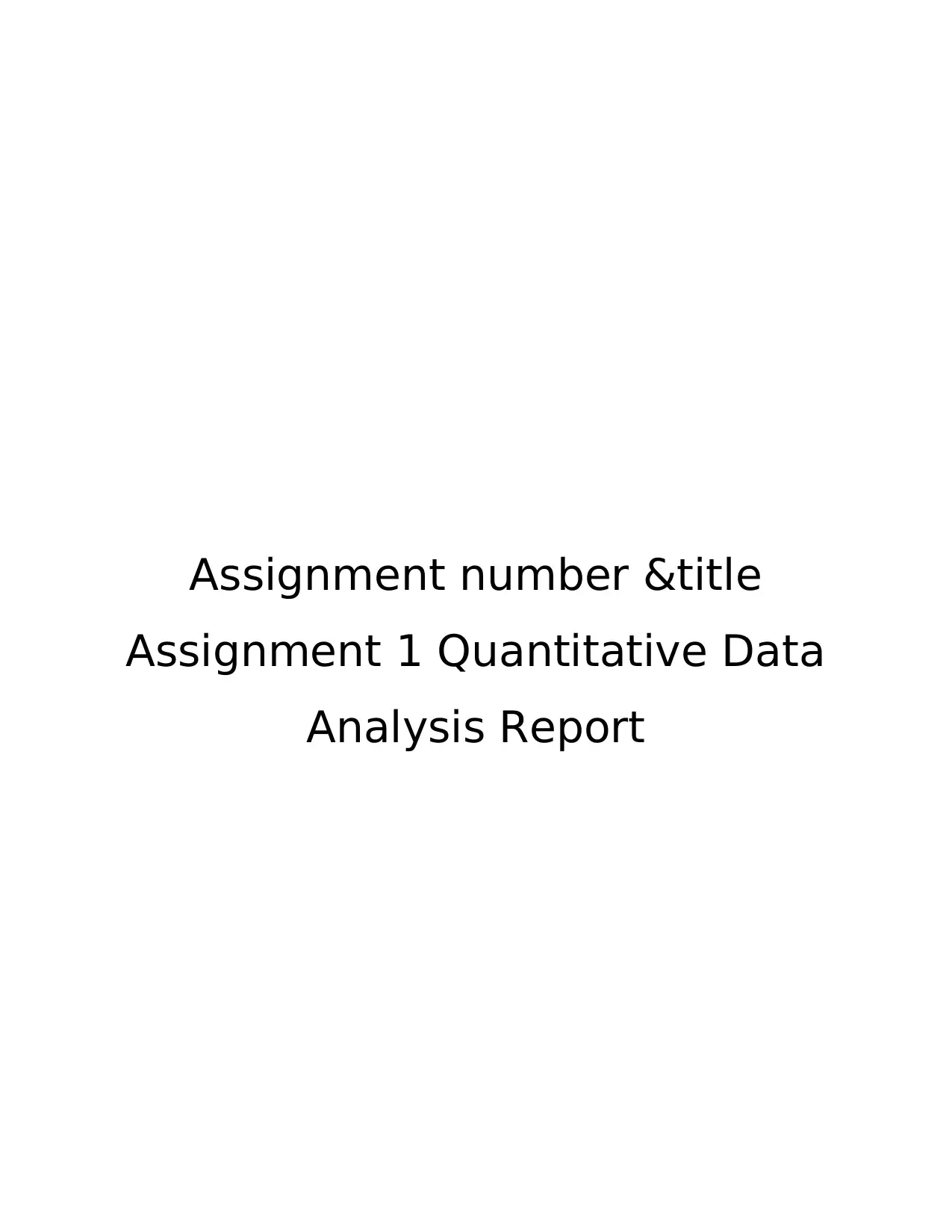
Assignment number &title
Assignment 1 Quantitative Data
Analysis Report
Assignment 1 Quantitative Data
Analysis Report
Paraphrase This Document
Need a fresh take? Get an instant paraphrase of this document with our AI Paraphraser
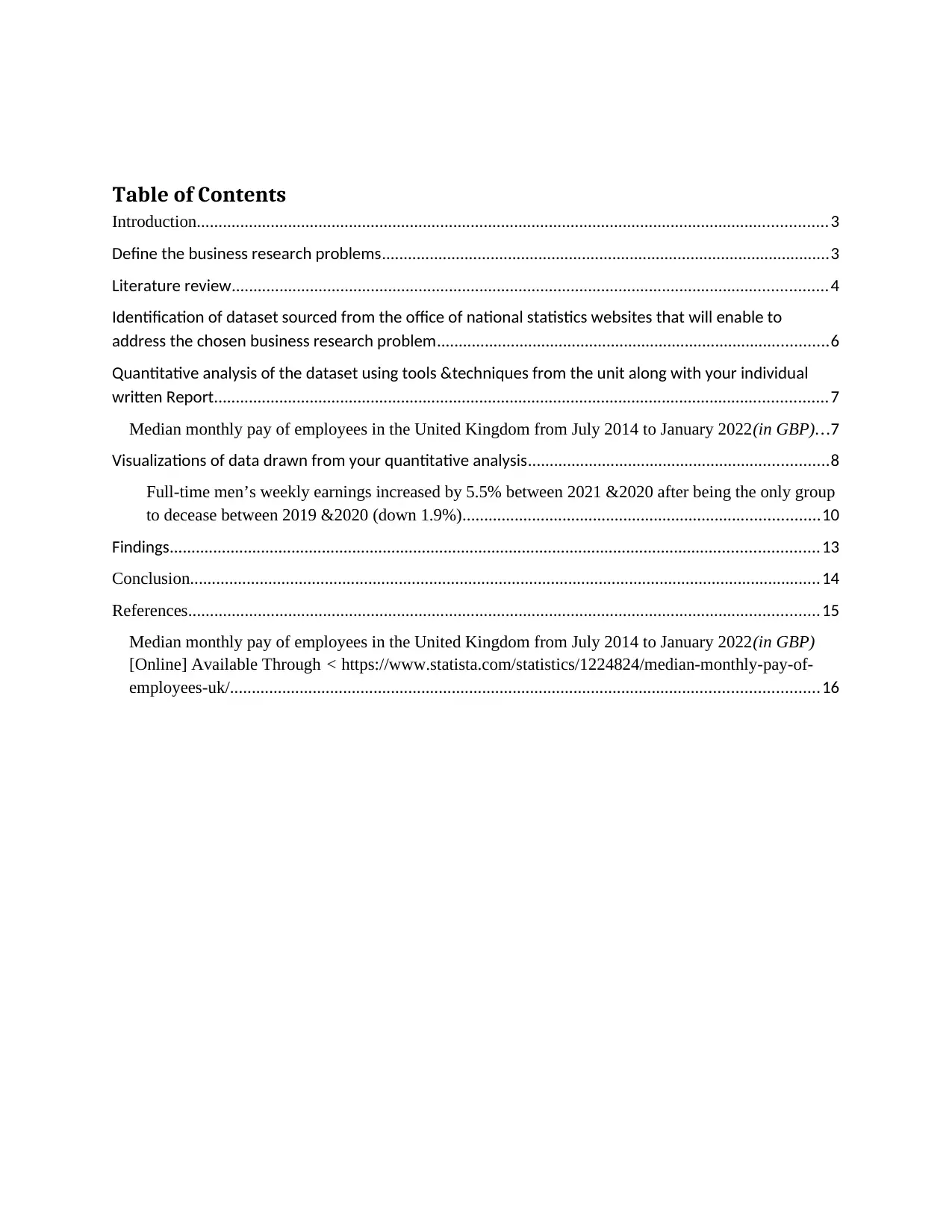
Table of Contents
Introduction.................................................................................................................................................3
Define the business research problems.......................................................................................................3
Literature review.........................................................................................................................................4
Identification of dataset sourced from the office of national statistics websites that will enable to
address the chosen business research problem..........................................................................................6
Quantitative analysis of the dataset using tools &techniques from the unit along with your individual
written Report.............................................................................................................................................7
Median monthly pay of employees in the United Kingdom from July 2014 to January 2022(in GBP)...7
Visualizations of data drawn from your quantitative analysis.....................................................................8
Full-time men’s weekly earnings increased by 5.5% between 2021 &2020 after being the only group
to decease between 2019 &2020 (down 1.9%)..................................................................................10
Findings.....................................................................................................................................................13
Conclusion.................................................................................................................................................14
References.................................................................................................................................................15
Median monthly pay of employees in the United Kingdom from July 2014 to January 2022(in GBP)
[Online] Available Through < https://www.statista.com/statistics/1224824/median-monthly-pay-of-
employees-uk/.......................................................................................................................................16
Introduction.................................................................................................................................................3
Define the business research problems.......................................................................................................3
Literature review.........................................................................................................................................4
Identification of dataset sourced from the office of national statistics websites that will enable to
address the chosen business research problem..........................................................................................6
Quantitative analysis of the dataset using tools &techniques from the unit along with your individual
written Report.............................................................................................................................................7
Median monthly pay of employees in the United Kingdom from July 2014 to January 2022(in GBP)...7
Visualizations of data drawn from your quantitative analysis.....................................................................8
Full-time men’s weekly earnings increased by 5.5% between 2021 &2020 after being the only group
to decease between 2019 &2020 (down 1.9%)..................................................................................10
Findings.....................................................................................................................................................13
Conclusion.................................................................................................................................................14
References.................................................................................................................................................15
Median monthly pay of employees in the United Kingdom from July 2014 to January 2022(in GBP)
[Online] Available Through < https://www.statista.com/statistics/1224824/median-monthly-pay-of-
employees-uk/.......................................................................................................................................16
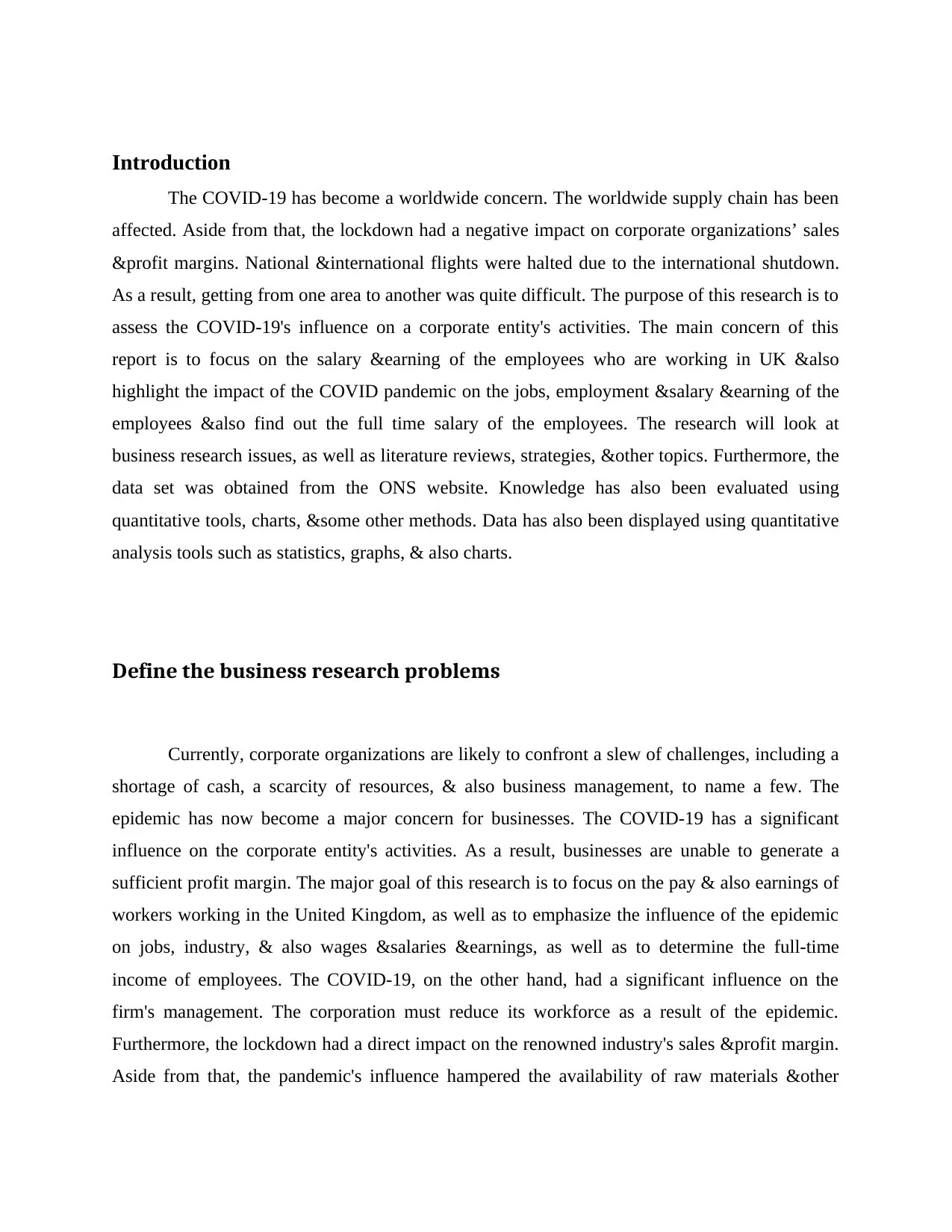
Introduction
The COVID-19 has become a worldwide concern. The worldwide supply chain has been
affected. Aside from that, the lockdown had a negative impact on corporate organizations’ sales
&profit margins. National &international flights were halted due to the international shutdown.
As a result, getting from one area to another was quite difficult. The purpose of this research is to
assess the COVID-19's influence on a corporate entity's activities. The main concern of this
report is to focus on the salary &earning of the employees who are working in UK &also
highlight the impact of the COVID pandemic on the jobs, employment &salary &earning of the
employees &also find out the full time salary of the employees. The research will look at
business research issues, as well as literature reviews, strategies, &other topics. Furthermore, the
data set was obtained from the ONS website. Knowledge has also been evaluated using
quantitative tools, charts, &some other methods. Data has also been displayed using quantitative
analysis tools such as statistics, graphs, & also charts.
Define the business research problems
Currently, corporate organizations are likely to confront a slew of challenges, including a
shortage of cash, a scarcity of resources, & also business management, to name a few. The
epidemic has now become a major concern for businesses. The COVID-19 has a significant
influence on the corporate entity's activities. As a result, businesses are unable to generate a
sufficient profit margin. The major goal of this research is to focus on the pay & also earnings of
workers working in the United Kingdom, as well as to emphasize the influence of the epidemic
on jobs, industry, & also wages &salaries &earnings, as well as to determine the full-time
income of employees. The COVID-19, on the other hand, had a significant influence on the
firm's management. The corporation must reduce its workforce as a result of the epidemic.
Furthermore, the lockdown had a direct impact on the renowned industry's sales &profit margin.
Aside from that, the pandemic's influence hampered the availability of raw materials &other
The COVID-19 has become a worldwide concern. The worldwide supply chain has been
affected. Aside from that, the lockdown had a negative impact on corporate organizations’ sales
&profit margins. National &international flights were halted due to the international shutdown.
As a result, getting from one area to another was quite difficult. The purpose of this research is to
assess the COVID-19's influence on a corporate entity's activities. The main concern of this
report is to focus on the salary &earning of the employees who are working in UK &also
highlight the impact of the COVID pandemic on the jobs, employment &salary &earning of the
employees &also find out the full time salary of the employees. The research will look at
business research issues, as well as literature reviews, strategies, &other topics. Furthermore, the
data set was obtained from the ONS website. Knowledge has also been evaluated using
quantitative tools, charts, &some other methods. Data has also been displayed using quantitative
analysis tools such as statistics, graphs, & also charts.
Define the business research problems
Currently, corporate organizations are likely to confront a slew of challenges, including a
shortage of cash, a scarcity of resources, & also business management, to name a few. The
epidemic has now become a major concern for businesses. The COVID-19 has a significant
influence on the corporate entity's activities. As a result, businesses are unable to generate a
sufficient profit margin. The major goal of this research is to focus on the pay & also earnings of
workers working in the United Kingdom, as well as to emphasize the influence of the epidemic
on jobs, industry, & also wages &salaries &earnings, as well as to determine the full-time
income of employees. The COVID-19, on the other hand, had a significant influence on the
firm's management. The corporation must reduce its workforce as a result of the epidemic.
Furthermore, the lockdown had a direct impact on the renowned industry's sales &profit margin.
Aside from that, the pandemic's influence hampered the availability of raw materials &other
⊘ This is a preview!⊘
Do you want full access?
Subscribe today to unlock all pages.

Trusted by 1+ million students worldwide
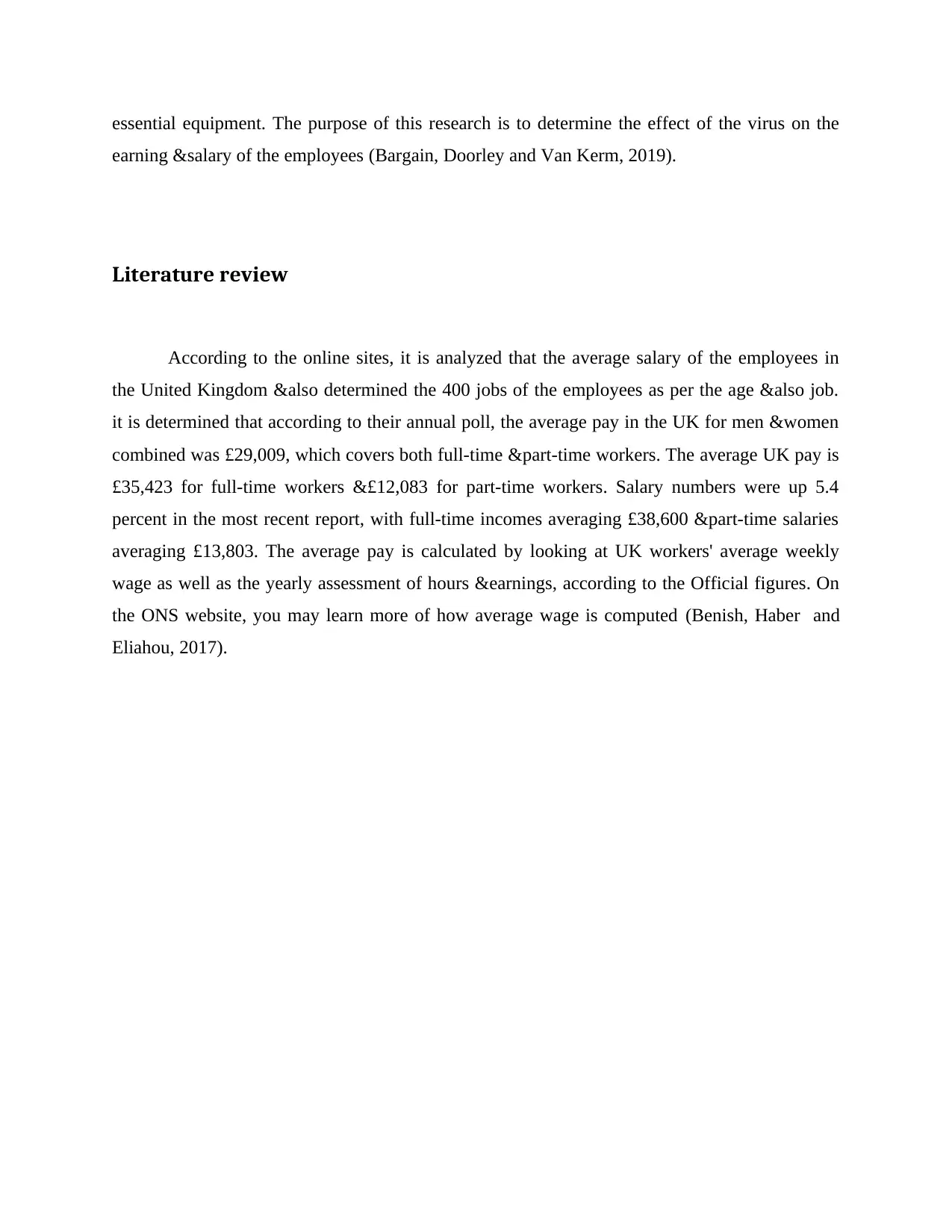
essential equipment. The purpose of this research is to determine the effect of the virus on the
earning &salary of the employees (Bargain, Doorley and Van Kerm, 2019).
Literature review
According to the online sites, it is analyzed that the average salary of the employees in
the United Kingdom &also determined the 400 jobs of the employees as per the age &also job.
it is determined that according to their annual poll, the average pay in the UK for men &women
combined was £29,009, which covers both full-time &part-time workers. The average UK pay is
£35,423 for full-time workers &£12,083 for part-time workers. Salary numbers were up 5.4
percent in the most recent report, with full-time incomes averaging £38,600 &part-time salaries
averaging £13,803. The average pay is calculated by looking at UK workers' average weekly
wage as well as the yearly assessment of hours &earnings, according to the Official figures. On
the ONS website, you may learn more of how average wage is computed (Benish, Haber and
Eliahou, 2017).
earning &salary of the employees (Bargain, Doorley and Van Kerm, 2019).
Literature review
According to the online sites, it is analyzed that the average salary of the employees in
the United Kingdom &also determined the 400 jobs of the employees as per the age &also job.
it is determined that according to their annual poll, the average pay in the UK for men &women
combined was £29,009, which covers both full-time &part-time workers. The average UK pay is
£35,423 for full-time workers &£12,083 for part-time workers. Salary numbers were up 5.4
percent in the most recent report, with full-time incomes averaging £38,600 &part-time salaries
averaging £13,803. The average pay is calculated by looking at UK workers' average weekly
wage as well as the yearly assessment of hours &earnings, according to the Official figures. On
the ONS website, you may learn more of how average wage is computed (Benish, Haber and
Eliahou, 2017).
Paraphrase This Document
Need a fresh take? Get an instant paraphrase of this document with our AI Paraphraser
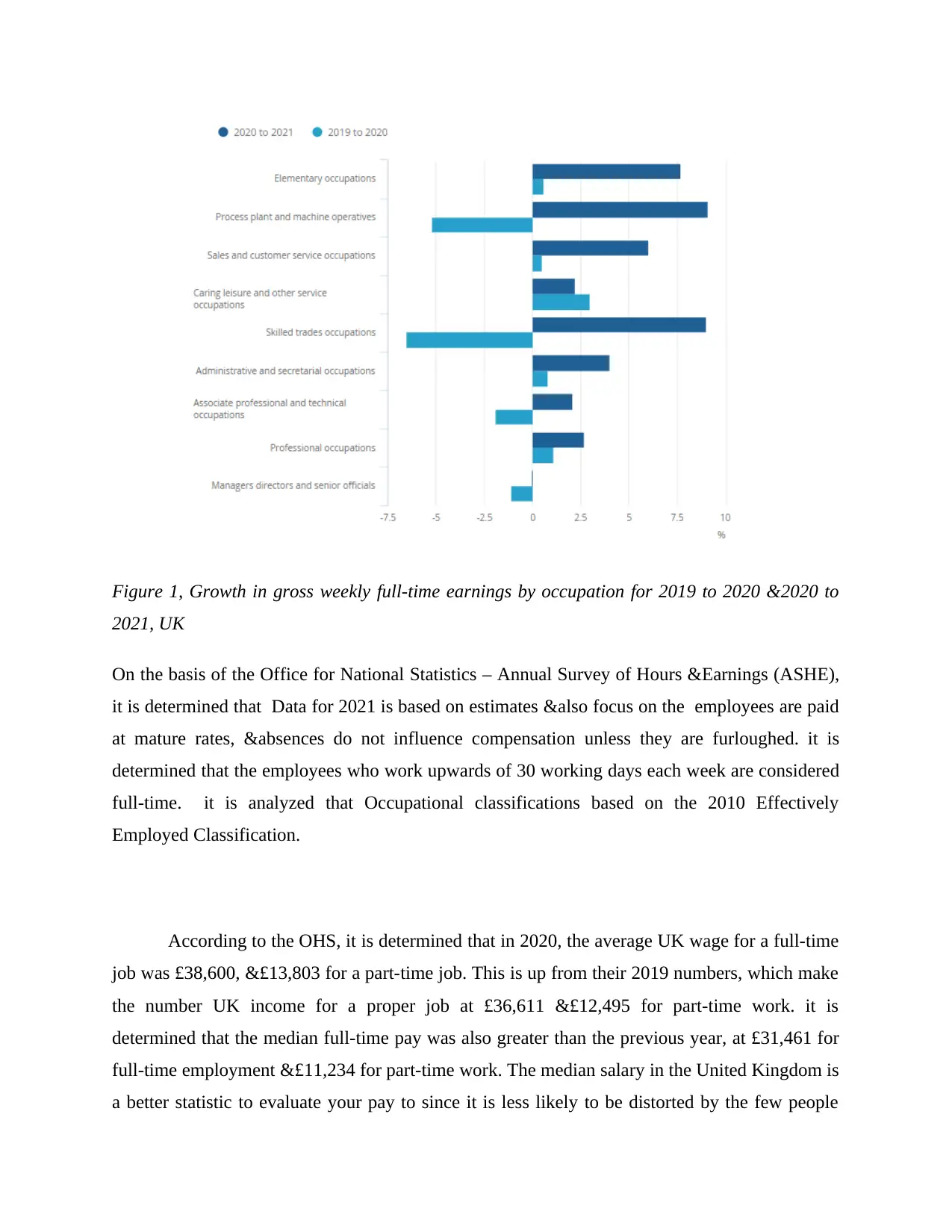
Figure 1, Growth in gross weekly full-time earnings by occupation for 2019 to 2020 &2020 to
2021, UK
On the basis of the Office for National Statistics – Annual Survey of Hours &Earnings (ASHE),
it is determined that Data for 2021 is based on estimates &also focus on the employees are paid
at mature rates, &absences do not influence compensation unless they are furloughed. it is
determined that the employees who work upwards of 30 working days each week are considered
full-time. it is analyzed that Occupational classifications based on the 2010 Effectively
Employed Classification.
According to the OHS, it is determined that in 2020, the average UK wage for a full-time
job was £38,600, &£13,803 for a part-time job. This is up from their 2019 numbers, which make
the number UK income for a proper job at £36,611 &£12,495 for part-time work. it is
determined that the median full-time pay was also greater than the previous year, at £31,461 for
full-time employment &£11,234 for part-time work. The median salary in the United Kingdom is
a better statistic to evaluate your pay to since it is less likely to be distorted by the few people
2021, UK
On the basis of the Office for National Statistics – Annual Survey of Hours &Earnings (ASHE),
it is determined that Data for 2021 is based on estimates &also focus on the employees are paid
at mature rates, &absences do not influence compensation unless they are furloughed. it is
determined that the employees who work upwards of 30 working days each week are considered
full-time. it is analyzed that Occupational classifications based on the 2010 Effectively
Employed Classification.
According to the OHS, it is determined that in 2020, the average UK wage for a full-time
job was £38,600, &£13,803 for a part-time job. This is up from their 2019 numbers, which make
the number UK income for a proper job at £36,611 &£12,495 for part-time work. it is
determined that the median full-time pay was also greater than the previous year, at £31,461 for
full-time employment &£11,234 for part-time work. The median salary in the United Kingdom is
a better statistic to evaluate your pay to since it is less likely to be distorted by the few people
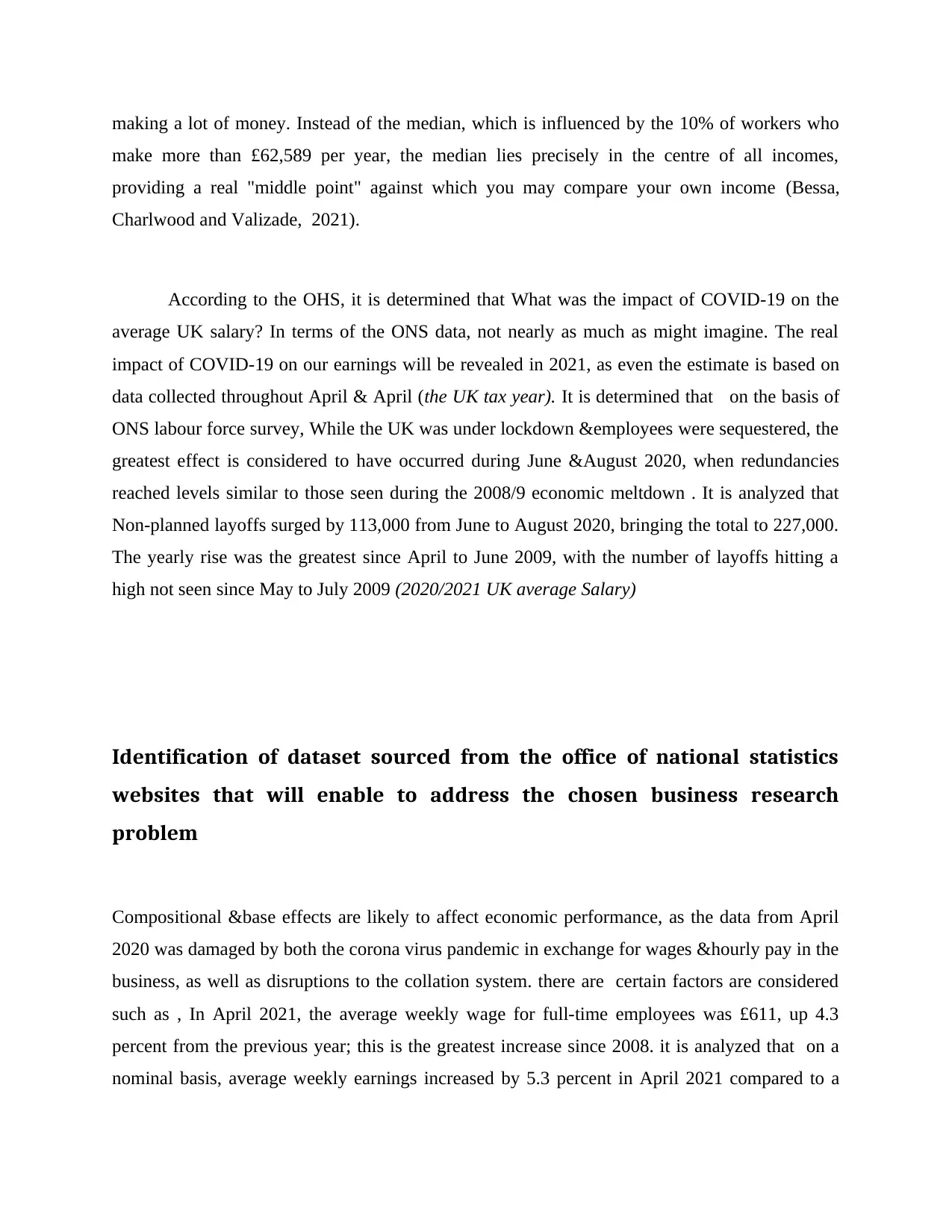
making a lot of money. Instead of the median, which is influenced by the 10% of workers who
make more than £62,589 per year, the median lies precisely in the centre of all incomes,
providing a real "middle point" against which you may compare your own income (Bessa,
Charlwood and Valizade, 2021).
According to the OHS, it is determined that What was the impact of COVID-19 on the
average UK salary? In terms of the ONS data, not nearly as much as might imagine. The real
impact of COVID-19 on our earnings will be revealed in 2021, as even the estimate is based on
data collected throughout April & April (the UK tax year). It is determined that on the basis of
ONS labour force survey, While the UK was under lockdown &employees were sequestered, the
greatest effect is considered to have occurred during June &August 2020, when redundancies
reached levels similar to those seen during the 2008/9 economic meltdown . It is analyzed that
Non-planned layoffs surged by 113,000 from June to August 2020, bringing the total to 227,000.
The yearly rise was the greatest since April to June 2009, with the number of layoffs hitting a
high not seen since May to July 2009 (2020/2021 UK average Salary)
Identification of dataset sourced from the office of national statistics
websites that will enable to address the chosen business research
problem
Compositional &base effects are likely to affect economic performance, as the data from April
2020 was damaged by both the corona virus pandemic in exchange for wages &hourly pay in the
business, as well as disruptions to the collation system. there are certain factors are considered
such as , In April 2021, the average weekly wage for full-time employees was £611, up 4.3
percent from the previous year; this is the greatest increase since 2008. it is analyzed that on a
nominal basis, average weekly earnings increased by 5.3 percent in April 2021 compared to a
make more than £62,589 per year, the median lies precisely in the centre of all incomes,
providing a real "middle point" against which you may compare your own income (Bessa,
Charlwood and Valizade, 2021).
According to the OHS, it is determined that What was the impact of COVID-19 on the
average UK salary? In terms of the ONS data, not nearly as much as might imagine. The real
impact of COVID-19 on our earnings will be revealed in 2021, as even the estimate is based on
data collected throughout April & April (the UK tax year). It is determined that on the basis of
ONS labour force survey, While the UK was under lockdown &employees were sequestered, the
greatest effect is considered to have occurred during June &August 2020, when redundancies
reached levels similar to those seen during the 2008/9 economic meltdown . It is analyzed that
Non-planned layoffs surged by 113,000 from June to August 2020, bringing the total to 227,000.
The yearly rise was the greatest since April to June 2009, with the number of layoffs hitting a
high not seen since May to July 2009 (2020/2021 UK average Salary)
Identification of dataset sourced from the office of national statistics
websites that will enable to address the chosen business research
problem
Compositional &base effects are likely to affect economic performance, as the data from April
2020 was damaged by both the corona virus pandemic in exchange for wages &hourly pay in the
business, as well as disruptions to the collation system. there are certain factors are considered
such as , In April 2021, the average weekly wage for full-time employees was £611, up 4.3
percent from the previous year; this is the greatest increase since 2008. it is analyzed that on a
nominal basis, average weekly earnings increased by 5.3 percent in April 2021 compared to a
⊘ This is a preview!⊘
Do you want full access?
Subscribe today to unlock all pages.

Trusted by 1+ million students worldwide
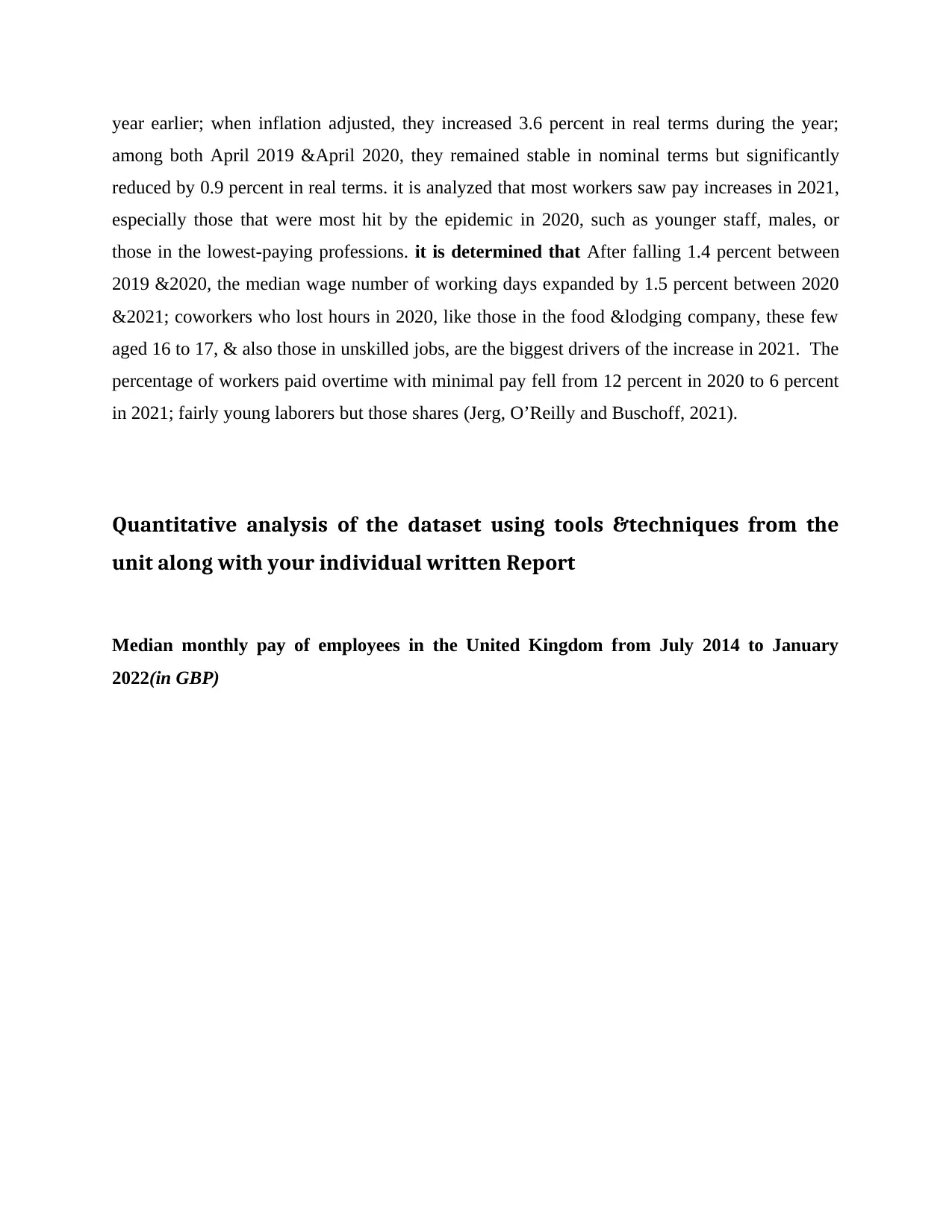
year earlier; when inflation adjusted, they increased 3.6 percent in real terms during the year;
among both April 2019 &April 2020, they remained stable in nominal terms but significantly
reduced by 0.9 percent in real terms. it is analyzed that most workers saw pay increases in 2021,
especially those that were most hit by the epidemic in 2020, such as younger staff, males, or
those in the lowest-paying professions. it is determined that After falling 1.4 percent between
2019 &2020, the median wage number of working days expanded by 1.5 percent between 2020
&2021; coworkers who lost hours in 2020, like those in the food &lodging company, these few
aged 16 to 17, & also those in unskilled jobs, are the biggest drivers of the increase in 2021. The
percentage of workers paid overtime with minimal pay fell from 12 percent in 2020 to 6 percent
in 2021; fairly young laborers but those shares (Jerg, O’Reilly and Buschoff, 2021).
Quantitative analysis of the dataset using tools &techniques from the
unit along with your individual written Report
Median monthly pay of employees in the United Kingdom from July 2014 to January
2022(in GBP)
among both April 2019 &April 2020, they remained stable in nominal terms but significantly
reduced by 0.9 percent in real terms. it is analyzed that most workers saw pay increases in 2021,
especially those that were most hit by the epidemic in 2020, such as younger staff, males, or
those in the lowest-paying professions. it is determined that After falling 1.4 percent between
2019 &2020, the median wage number of working days expanded by 1.5 percent between 2020
&2021; coworkers who lost hours in 2020, like those in the food &lodging company, these few
aged 16 to 17, & also those in unskilled jobs, are the biggest drivers of the increase in 2021. The
percentage of workers paid overtime with minimal pay fell from 12 percent in 2020 to 6 percent
in 2021; fairly young laborers but those shares (Jerg, O’Reilly and Buschoff, 2021).
Quantitative analysis of the dataset using tools &techniques from the
unit along with your individual written Report
Median monthly pay of employees in the United Kingdom from July 2014 to January
2022(in GBP)
Paraphrase This Document
Need a fresh take? Get an instant paraphrase of this document with our AI Paraphraser
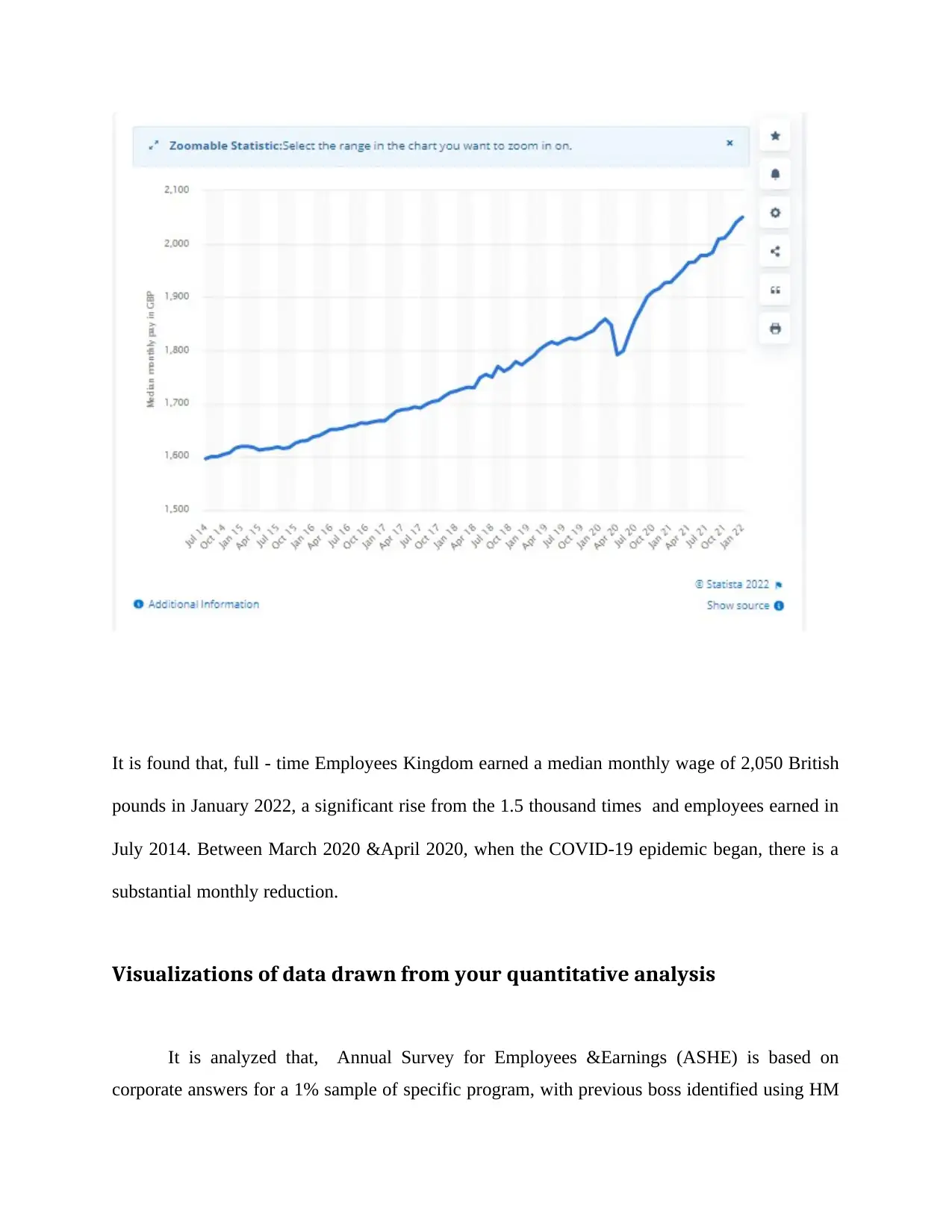
It is found that, full - time Employees Kingdom earned a median monthly wage of 2,050 British
pounds in January 2022, a significant rise from the 1.5 thousand times and employees earned in
July 2014. Between March 2020 &April 2020, when the COVID-19 epidemic began, there is a
substantial monthly reduction.
Visualizations of data drawn from your quantitative analysis
It is analyzed that, Annual Survey for Employees &Earnings (ASHE) is based on
corporate answers for a 1% sample of specific program, with previous boss identified using HM
pounds in January 2022, a significant rise from the 1.5 thousand times and employees earned in
July 2014. Between March 2020 &April 2020, when the COVID-19 epidemic began, there is a
substantial monthly reduction.
Visualizations of data drawn from your quantitative analysis
It is analyzed that, Annual Survey for Employees &Earnings (ASHE) is based on
corporate answers for a 1% sample of specific program, with previous boss identified using HM
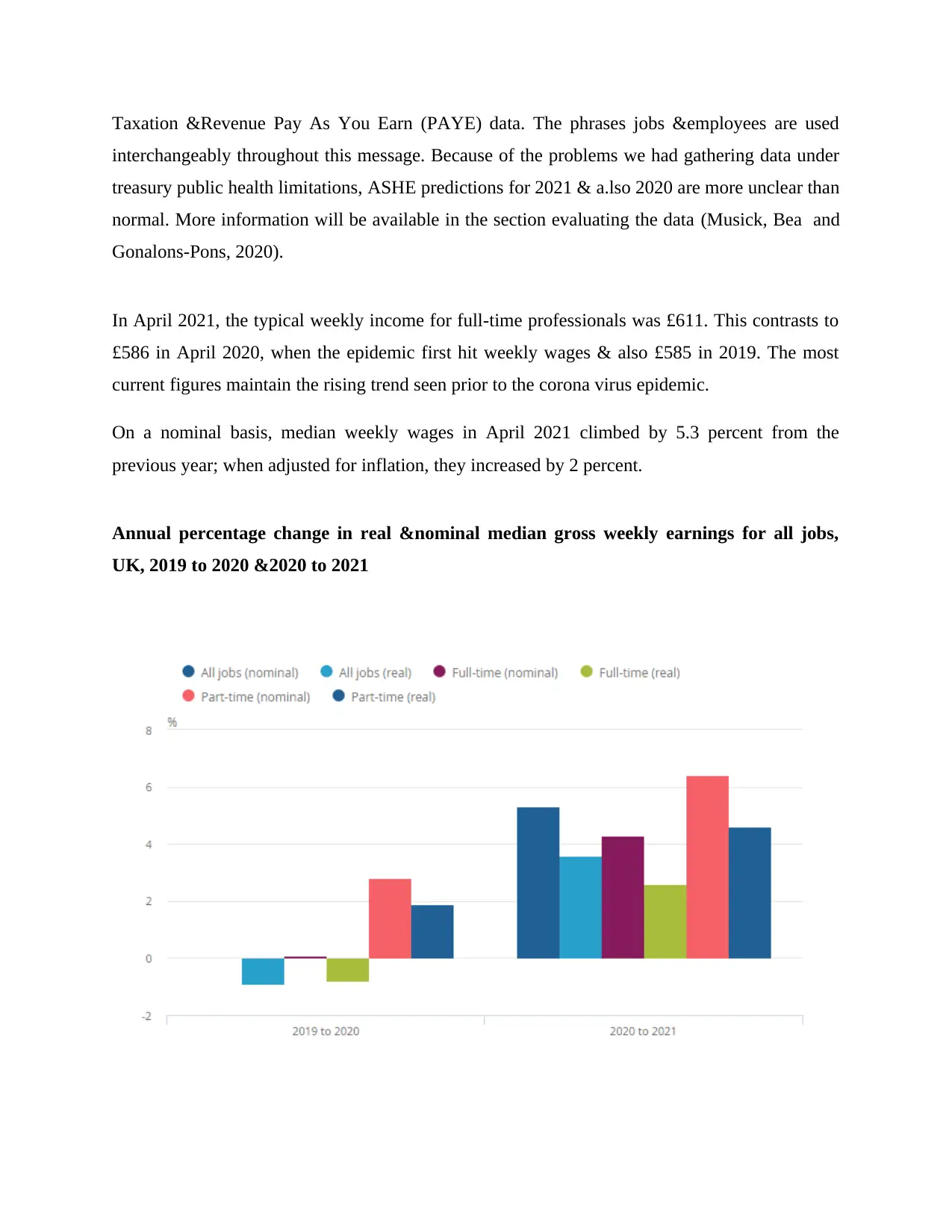
Taxation &Revenue Pay As You Earn (PAYE) data. The phrases jobs &employees are used
interchangeably throughout this message. Because of the problems we had gathering data under
treasury public health limitations, ASHE predictions for 2021 & a.lso 2020 are more unclear than
normal. More information will be available in the section evaluating the data (Musick, Bea and
Gonalons-Pons, 2020).
In April 2021, the typical weekly income for full-time professionals was £611. This contrasts to
£586 in April 2020, when the epidemic first hit weekly wages & also £585 in 2019. The most
current figures maintain the rising trend seen prior to the corona virus epidemic.
On a nominal basis, median weekly wages in April 2021 climbed by 5.3 percent from the
previous year; when adjusted for inflation, they increased by 2 percent.
Annual percentage change in real &nominal median gross weekly earnings for all jobs,
UK, 2019 to 2020 &2020 to 2021
interchangeably throughout this message. Because of the problems we had gathering data under
treasury public health limitations, ASHE predictions for 2021 & a.lso 2020 are more unclear than
normal. More information will be available in the section evaluating the data (Musick, Bea and
Gonalons-Pons, 2020).
In April 2021, the typical weekly income for full-time professionals was £611. This contrasts to
£586 in April 2020, when the epidemic first hit weekly wages & also £585 in 2019. The most
current figures maintain the rising trend seen prior to the corona virus epidemic.
On a nominal basis, median weekly wages in April 2021 climbed by 5.3 percent from the
previous year; when adjusted for inflation, they increased by 2 percent.
Annual percentage change in real &nominal median gross weekly earnings for all jobs,
UK, 2019 to 2020 &2020 to 2021
⊘ This is a preview!⊘
Do you want full access?
Subscribe today to unlock all pages.

Trusted by 1+ million students worldwide
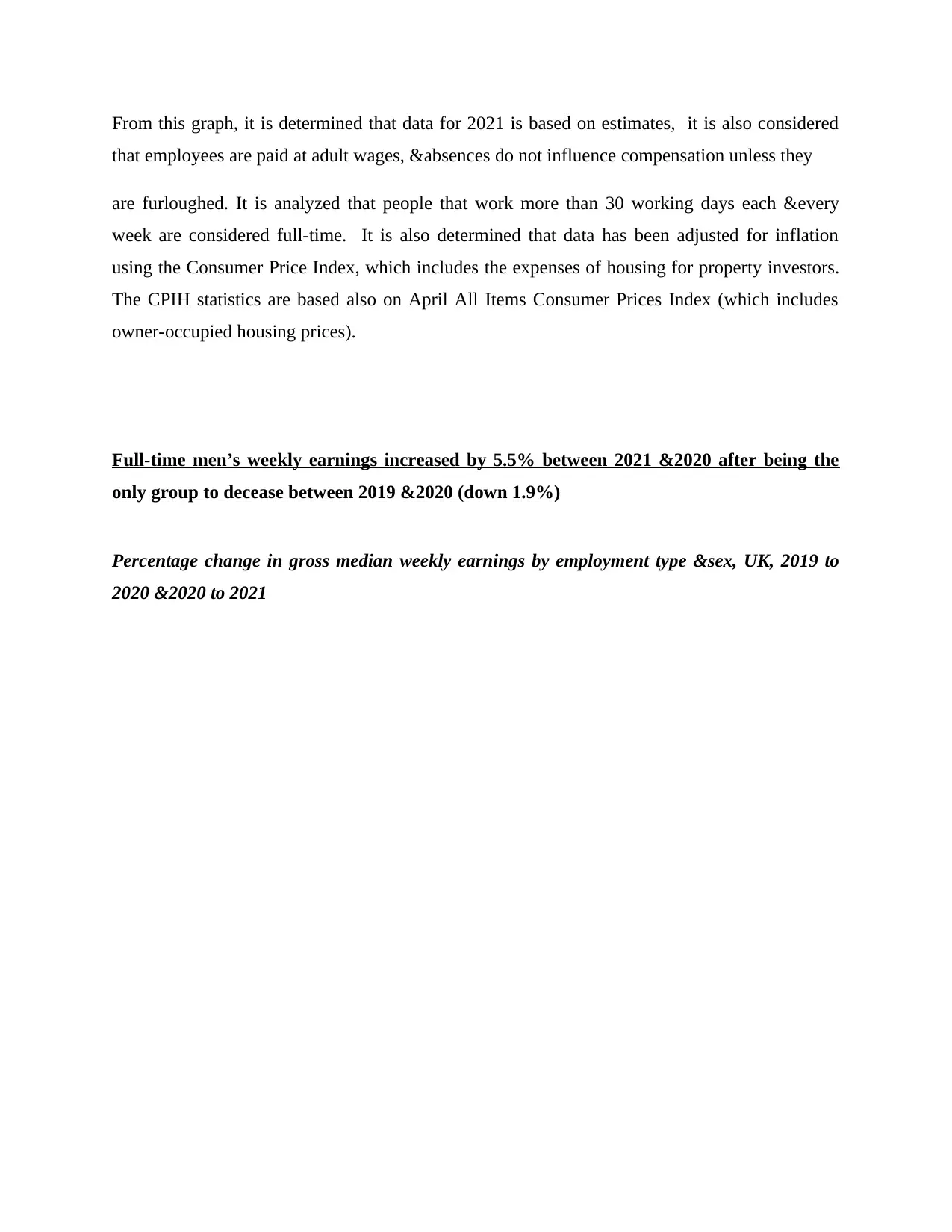
From this graph, it is determined that data for 2021 is based on estimates, it is also considered
that employees are paid at adult wages, &absences do not influence compensation unless they
are furloughed. It is analyzed that people that work more than 30 working days each &every
week are considered full-time. It is also determined that data has been adjusted for inflation
using the Consumer Price Index, which includes the expenses of housing for property investors.
The CPIH statistics are based also on April All Items Consumer Prices Index (which includes
owner-occupied housing prices).
Full-time men’s weekly earnings increased by 5.5% between 2021 &2020 after being the
only group to decease between 2019 &2020 (down 1.9%)
Percentage change in gross median weekly earnings by employment type &sex, UK, 2019 to
2020 &2020 to 2021
that employees are paid at adult wages, &absences do not influence compensation unless they
are furloughed. It is analyzed that people that work more than 30 working days each &every
week are considered full-time. It is also determined that data has been adjusted for inflation
using the Consumer Price Index, which includes the expenses of housing for property investors.
The CPIH statistics are based also on April All Items Consumer Prices Index (which includes
owner-occupied housing prices).
Full-time men’s weekly earnings increased by 5.5% between 2021 &2020 after being the
only group to decease between 2019 &2020 (down 1.9%)
Percentage change in gross median weekly earnings by employment type &sex, UK, 2019 to
2020 &2020 to 2021
Paraphrase This Document
Need a fresh take? Get an instant paraphrase of this document with our AI Paraphraser
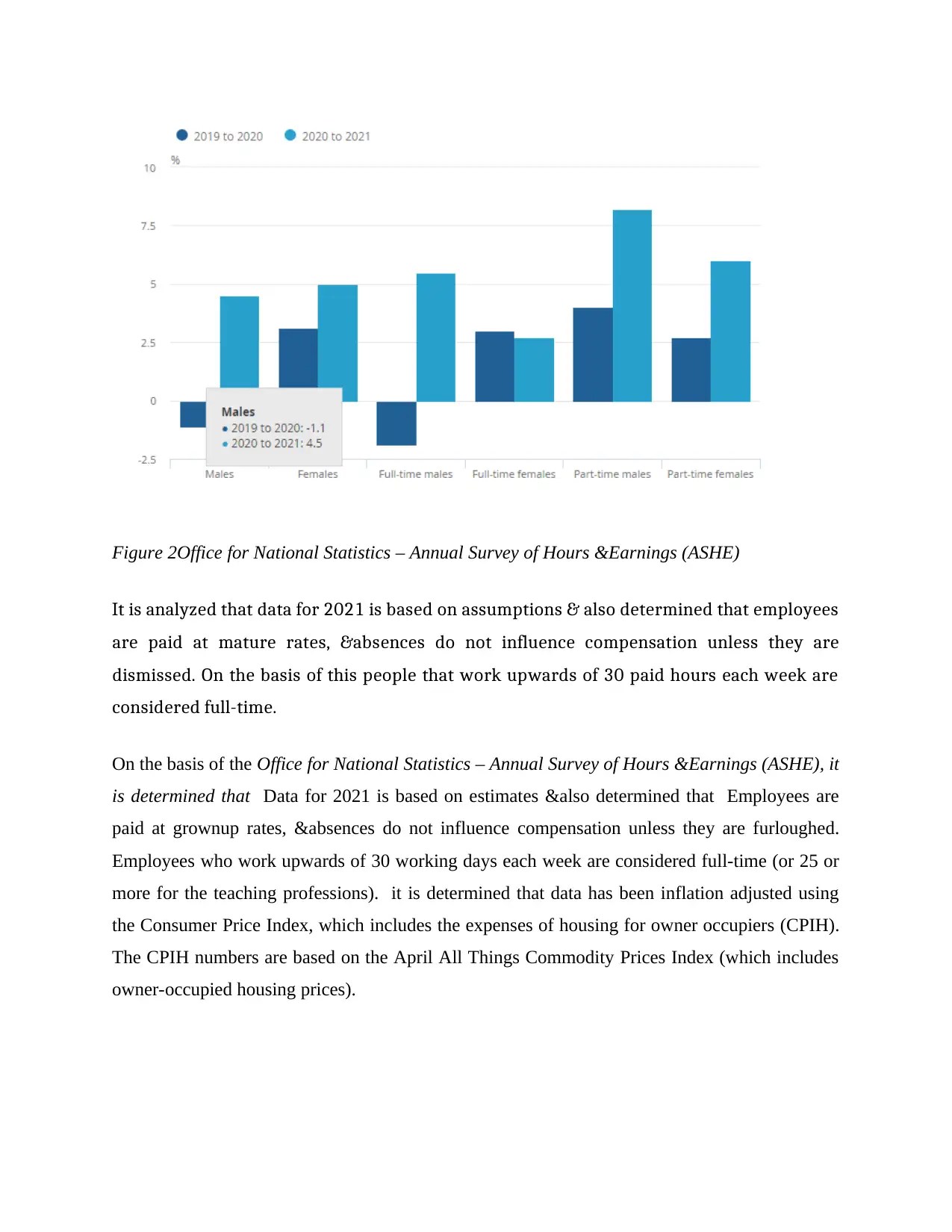
Figure 2Office for National Statistics – Annual Survey of Hours &Earnings (ASHE)
It is analyzed that data for 2021 is based on assumptions & also determined that employees
are paid at mature rates, &absences do not influence compensation unless they are
dismissed. On the basis of this people that work upwards of 30 paid hours each week are
considered full-time.
On the basis of the Office for National Statistics – Annual Survey of Hours &Earnings (ASHE), it
is determined that Data for 2021 is based on estimates &also determined that Employees are
paid at grownup rates, &absences do not influence compensation unless they are furloughed.
Employees who work upwards of 30 working days each week are considered full-time (or 25 or
more for the teaching professions). it is determined that data has been inflation adjusted using
the Consumer Price Index, which includes the expenses of housing for owner occupiers (CPIH).
The CPIH numbers are based on the April All Things Commodity Prices Index (which includes
owner-occupied housing prices).
It is analyzed that data for 2021 is based on assumptions & also determined that employees
are paid at mature rates, &absences do not influence compensation unless they are
dismissed. On the basis of this people that work upwards of 30 paid hours each week are
considered full-time.
On the basis of the Office for National Statistics – Annual Survey of Hours &Earnings (ASHE), it
is determined that Data for 2021 is based on estimates &also determined that Employees are
paid at grownup rates, &absences do not influence compensation unless they are furloughed.
Employees who work upwards of 30 working days each week are considered full-time (or 25 or
more for the teaching professions). it is determined that data has been inflation adjusted using
the Consumer Price Index, which includes the expenses of housing for owner occupiers (CPIH).
The CPIH numbers are based on the April All Things Commodity Prices Index (which includes
owner-occupied housing prices).
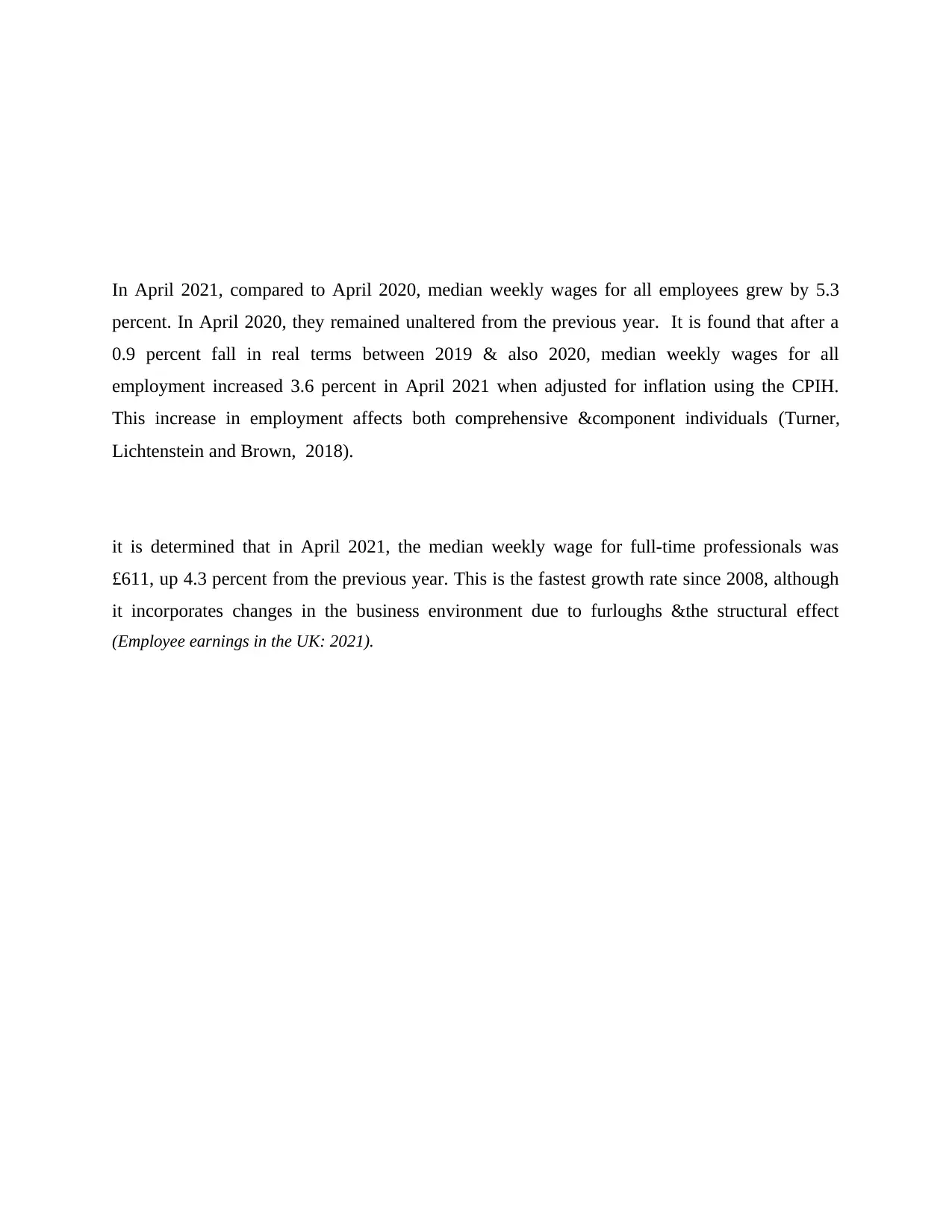
In April 2021, compared to April 2020, median weekly wages for all employees grew by 5.3
percent. In April 2020, they remained unaltered from the previous year. It is found that after a
0.9 percent fall in real terms between 2019 & also 2020, median weekly wages for all
employment increased 3.6 percent in April 2021 when adjusted for inflation using the CPIH.
This increase in employment affects both comprehensive &component individuals (Turner,
Lichtenstein and Brown, 2018).
it is determined that in April 2021, the median weekly wage for full-time professionals was
£611, up 4.3 percent from the previous year. This is the fastest growth rate since 2008, although
it incorporates changes in the business environment due to furloughs &the structural effect
(Employee earnings in the UK: 2021).
percent. In April 2020, they remained unaltered from the previous year. It is found that after a
0.9 percent fall in real terms between 2019 & also 2020, median weekly wages for all
employment increased 3.6 percent in April 2021 when adjusted for inflation using the CPIH.
This increase in employment affects both comprehensive &component individuals (Turner,
Lichtenstein and Brown, 2018).
it is determined that in April 2021, the median weekly wage for full-time professionals was
£611, up 4.3 percent from the previous year. This is the fastest growth rate since 2008, although
it incorporates changes in the business environment due to furloughs &the structural effect
(Employee earnings in the UK: 2021).
⊘ This is a preview!⊘
Do you want full access?
Subscribe today to unlock all pages.

Trusted by 1+ million students worldwide
1 out of 16
Related Documents
Your All-in-One AI-Powered Toolkit for Academic Success.
+13062052269
info@desklib.com
Available 24*7 on WhatsApp / Email
![[object Object]](/_next/static/media/star-bottom.7253800d.svg)
Unlock your academic potential
Copyright © 2020–2025 A2Z Services. All Rights Reserved. Developed and managed by ZUCOL.





